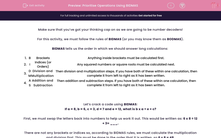Make sure that you’ve got your thinking cap on as we are going to be number decoders!
For this activity, we must follow the rules of BIDMAS (or you may know them as BODMAS).
BIDMAS tells us the order in which we should answer long calculations:
| 1. | B | Brackets | Anything inside brackets must be calculated first. |
| 2. | I | Indices (or Orders) | Any squared numbers or square roots must be calculated next. |
| 3. |
D M |
Division and Multiplication |
Then division and multiplication steps. If you have both of these within one calculation, then complete it from left to right as it has been written. |
| 4. |
A S |
Addition and Subtraction |
Then addition and subtraction steps. If you have both of these within one calculation, then complete it from left to right as it has been written. |
Let’s crack a code using BIDMAS:
If a = 8, b = 6, c = 3, d = 7 and e = 12, what is b x a ÷ e + c?
First, we must swap the letters back into numbers to help us work it out. This would be written as: 6 x 8 ÷ 12 + 3= ___.
There are not any brackets or indices so, according to BIDMAS rules, we must calculate the multiplication and division first. This must be done in the order that it is written, so 6 x 8 = 48.
Then we are left with: 48 ÷ 12 + 3.
Following BIDMAS, let’s do the division first, 48 ÷ 12 = 4.
Then we are left with 4 + 3 = 7.
So the answer is 7 but we must convert this back into a letter. The number 7 is represented by the letter d, therefore d is the final answer.
Let’s try one more and write the answer as a letter:
If a = 4, b = 125 , c = 3, d = 11 and e = 7, what is d (c x a) - e?
Where there isn’t a -, +, x or ÷ between the first letter and the bracket, it means we have to multiply the outside number by what is in the brackets.
So the steps we follow are:
c x a = 12
d x 12 = 132
132 - e = 125
We must turn the number 125 back into a letter. This number corresponds to the letter b.
Now it’s your turn to crack the codes. Good luck number detective!








